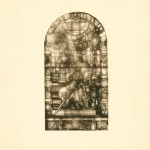As an archivist, my job is to make connections. Whether it’s connecting researchers to the information found in archival collections or finding the patterns as to why and how materials were created, used, and collected, I am constantly connecting the dots to tell a story in order to—excuse the cliché—bring history to life. The relationships between the items of a collection illustrate how a person lived or how an organization functioned.
My favorite part of archival work is the connections I make with the individual or group whose personal materials I am exploring. Most recently, I connected with the life of Frederick Wilson, a stained glass artist from the early 20th century. Some on the library staff say I developed a bit of a crush!
This innovative, yet unassuming, English artist emerged as one of the most prolific designers of stained glass in America at the turn of the century. He worked at Tiffany Studios for three decades, managing the ecclesiastical department from 1899 until 1923. Very little is published on Wilson, and he’s become mostly a footnote in the literature about the different firms for which he worked. His story has been overlooked and much of it lost. Fortunately, the Rakow Research Library possesses two archival collections containing personal documents and artwork that shed some light on the story of his life and work. I recently had the pleasure of arranging and describing both these collections to create guides, or finding aids, which provide a summary or snapshot of what a researcher can expect to find in each collection.
I discovered a man dedicated to both his craft and family while creating the finding aid for the Jeffrey Rush Higgins Collection on Frederick Wilson. Wilson’s personal scrapbooks from this collection include watercolor studies and pencil and ink sketches that attest to his constant study of the human form, and his desire to make his stained glass figures realistic. Letters from clients and his assistants at Tiffany illustrate a man devoted to teamwork and artistic integrity. When I am surrounded by these personal materials that make up a life, it’s difficult not to feel like I know the person.
I didn’t expect to find a local connection while processing the Wilson collections, but that’s exactly what happened when I started working on the Judson Studios Photograph Collection of Frederick Wilson Design Drawings. This collection contains photographs of designs for the stained glass windows installed at a local church. Nestled in the hills of Lake Keuka, the charming Garrett Memorial Chapel honors the memory of the Garrett family’s son. The family commissioned Wilson to design all 18 windows of the chapel. These were the last windows he would work on before his death in 1932.
Excited to discover this local connection, I knew I needed to see the windows in person. It is difficult to put into words how it felt to view these magnificent pieces of colored glass, the sun glinting off them on a beautiful fall day. Since the photographs of the designs are in black and white, I had no idea what color the glass would be for each window. So I was stunned by the windows’ multi-colored panels rendered in the richest hues that almost made the images three-dimensional. Seeing the process from design to completed window was truly satisfying.
- Design for stained glass window of kneeling Sir Galahad, circa 1930-1932. CMGL 111054.
- The Sir Galahad window at Garrett Chapel.
Making connections with the Frederick Wilson collections is gratifying, but my main goal as an archivist is to connect researchers with the collections I oversee. Come explore the Rakow’s archival collections and discover connections of your own!
The Rakow Research Library is open to the public 9am to 5pm every day. We encourage everyone to explore our collections in person or online. If you have questions or need help with your research, please use our Ask a Glass Question service.





